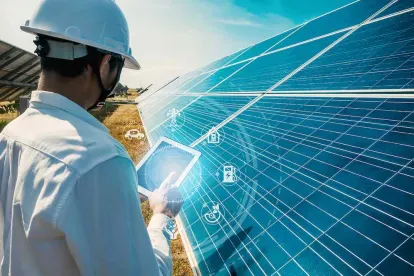On August 16, 2022, President Biden signed the Inflation Reduction Act (the Act), which includes provisions extending the production tax credit (PTC) and the investment tax credit (ITC) for solar and offshore wind projects. In addition, the Act adds a 15% minimum book income tax for corporations, which may be offset in part by general business credits, including solar and wind energy tax credits.
I. Tax Credits Generally
Under the Act, a 0.3-cent-per-kilowatt-hour PTC, scaled up to 1.5 cents per kilowatt hour for facilities that pay prevailing wages and meet certain apprenticeship requirements, is available for facilities that begin construction before January 1, 2025. The PTC amount is also inflation adjusted. Alternatively, projects may qualify for a 6% ITC, scaled up to 30% for facilities that meet certain wage and apprenticeship requirements, that begin construction before January 1, 2025. Offshore wind projects that begin construction before January 1, 2026, may also qualify for the ITC.
II. Domestic Content Bonus Credit
For taxpayers using the ITC, an additional 2% domestic content bonus credit (scaled up to 10% if the project meets the above wage and apprenticeship requirements) is available for solar or wind projects that use US-produced iron, steel, and manufactured products. For taxpayers using the PTC, the 10% domestic content bonus credit is available for projects that use US-produced iron, steel, and manufactured products and meet the above wage and apprenticeship requirements. Manufactured products are deemed to be domestically produced so long as a percentage of the manufactured products in a facility are mined, produced, or manufactured in the United States. For offshore wind projects beginning construction before January 1, 2025, the percentage applicable to manufactured products in the United States is 20%, which rises in steps to 55% for projects beginning in 2028. For all other projects beginning construction before January 1, 2025, the percentage for domestic manufactured products increases to 40%, which rises in steps to 55% for projects beginning construction in 2027.
III. Advanced Manufacturing Production Credit
The Act also provides a new advanced manufacturing production tax credit (AMPTC) for the domestic production of solar and wind components and related goods. For offshore wind vessels, the AMPTC is 10% of the sales price of such vessel. For other offshore wind components, the credit amount is based on the type of component multiplied by the total rated capacity of the project, with credits available for blades, nacelles, towers, and offshore wind foundations. Below is the list of the credits available for each wind component:
-
Blade — 2 cents
-
Nacelle — 5 cents
-
Tower — 3 cents
-
Offshore wind foundations:
a. If using a fixed platform — 2 cents
b. If using a floating platform — 4 cents
By way of example, a nacelle produced for a 10 megawatt project and sold by the taxpayer to an unrelated person is eligible for a $500,000 tax credit.
The Act also lists credit amounts for various solar components, such as:
-
Photovoltaic cells — 4 cents multiplied by the cell’s capacity
-
Photovoltaic wafers — $12 per square meter
-
Solar grade polysilicon — $3 per kilogram
-
Polymeric backsheets — 40 cents per square meter
-
Solar modules — 7 cents multiplied by the module’s capacity
IV. Small Projects in Low-Income Communities
Beginning in 2023, certain solar and wind projects eligible for the ITC also benefit from an additional tax credit if they have a maximum net output of less than 5 megawatts and are placed in service in connection with low-income communities. The additional energy credit is 10% for those projects located in low-income communities, increased to 20% for projects that are part of a qualified low-income residential building project or a qualified low-income economic benefit project.
V. Direct Pay
Also beginning in 2023, tax-exempt entities, state and local governments and political subdivisions, the Tennessee Valley Authority, tribal governments, Alaska Native Corporations, and cooperatives that furnish electricity to rural areas may elect to receive a direct payment in lieu of any applicable credit, including the PTC, ITC, and AMPTC. Other taxpayers may be eligible for direct pay of the AMPTC but with certain limitations.
VI. Transferability
The Act also allows taxpayers to elect to transfer all or a portion of an eligible tax credit (including the PTC, ITC, and AMPTC) to an unrelated eligible taxpayer for taxable years beginning in 2023. The recipient taxpayer may not further transfer any portion of the transferred credit. Tax credits may not be transferred to tax-exempt entities, state and local governments and political subdivisions, the Tennessee Valley Authority, tribal governments, Alaska Native Corporations, and cooperatives that furnish electricity to rural areas.





 />i
/>i

